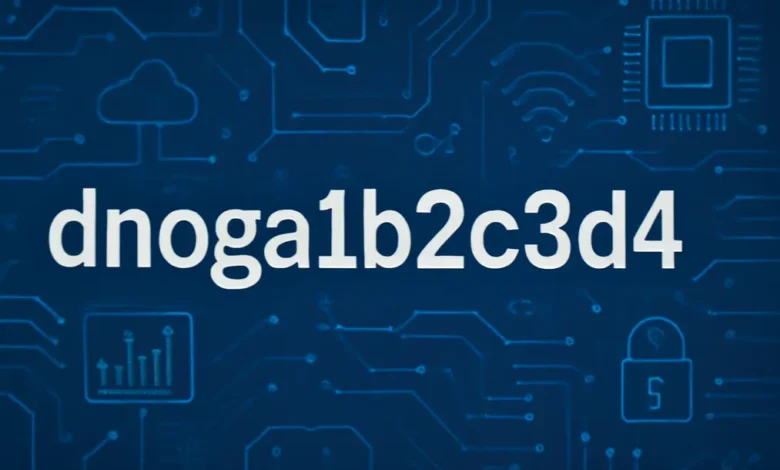What is dnoga1b2c3d4?
Dnoga1b2c3d4 is an innovative concept that has emerged as a crucial factor in various contemporary fields, fundamentally influencing how tasks are approached and executed. It is an intricate framework designed to enhance efficiency and effectiveness across a multitude of applications, thereby establishing its significance in the current landscape. Understanding dnoga1b2c3d4 requires an exploration of its origins and the contexts in which it holds particular relevance.
The term “dnoga1b2c3d4” encompasses a range of principles and methodologies that have developed over time, influenced by advancements in technology and shifts in industry practices. Its genesis can be traced back to the early stages of systematic research aimed at optimizing processes, and it has evolved to address the complexities faced by modern organizations. As such, dnoga1b2c3d4 is not merely a theoretical construct; it is a practical tool that is increasingly being integrated into business strategies, educational curricula, and technological developments.
The applications of dnoga1b2c3d4 are vast and varied. In the realm of business, it aids organizations in streamlining operations and maximizing productivity, while in education, it fosters a structured approach to learning and knowledge acquisition. Additionally, the technology sector has leveraged dnoga1b2c3d4 to develop solutions that are not only efficient but also adaptive to changing circumstances. Thus, understanding this multifaceted concept is essential for professionals and enthusiasts alike, as it collectively echoes the pressing need for innovation and adaptability in today’s fast-paced environment. The growing discourse surrounding dnoga1b2c3d4 is indicative of its emerging significance, underlining why it deserves further exploration and attention.
The Mechanisms Behind dnoga1b2c3d4
To comprehend the intricacies of dnoga1b2c3d4, it is essential to explore the underlying mechanisms that facilitate its operations. At the core of this technology lie several fundamental scientific principles. The mechanisms can be categorized into various processes including biochemical interactions, signal transduction pathways, and molecular dynamics. These processes work in unison to ensure that dnoga1b2c3d4 achieves its intended outcomes efficiently and effectively.
Research indicates that one of the critical ways in which dnoga1b2c3d4 exerts its effects is through the modulation of specific pathways that govern cellular responses. For instance, studies have shown that it interacts with various receptors and enzymes, resulting in significant biochemical changes. These interactions often trigger a cascade of events, which can lead to alterations in cellular behavior and functionality. Understanding these pathways allows researchers to leverage dnoga1b2c3d4’s capabilities in practical applications, particularly in fields such as pharmaceuticals and biotechnology.
Moreover, advancements in technology have been pivotal in elucidating the molecular dynamics associated with dnoga1b2c3d4. Sophisticated imaging techniques and computational modeling have enabled scientists to visualize and predict how this compound interacts with other molecules at the atomic level. Such insights have yielded critical data that enhance our understanding of how dnoga1b2c3d4 operates, offering a clearer picture of its role in various biological processes.
As we continue to investigate these mechanisms, it becomes evident that the implications of dnoga1b2c3d4 extend beyond theoretical frameworks. The practical applications resulting from this knowledge include innovative therapeutic strategies and improved methods for disease management. Therefore, comprehending the mechanisms behind dnoga1b2c3d4 not only enriches our knowledge base but also paves the way for significant advancements in multiple domains.
Benefits and Challenges of Using dnoga1b2c3d4
The application of dnoga1b2c3d4 offers numerous benefits, contributing significantly to various fields and methodologies. One of the foremost advantages is its efficiency. By streamlining processes, dnoga1b2c3d4 helps in reducing time and resource investments, thereby enabling users to achieve their objectives more swiftly. This boost in operational efficiency is particularly apparent in contexts requiring rapid decision-making and adaptability.
Additionally, the effectiveness of dnoga1b2c3d4 is noteworthy. Users report improved outcomes across different scenarios, owing to its capacity for facilitating better analyses and enhanced performance. This effectiveness extends to both individual and collective efforts, showcasing dnoga1b2c3d4 as a tool that drives optimal results. Moreover, its scalability allows for flexibility—whether one is addressing small-scale projects or extensive operations, dnoga1b2c3d4 can accommodate varying levels of demand, making it a versatile solution.
However, the implementation of dnoga1b2c3d4 is not without its challenges. Users may face a steep learning curve, particularly if the system or methodology is inherently complex. This can lead to initial setbacks, as users navigate the intricacies involved in effectively leveraging dnoga1b2c3d4. Furthermore, the dependency on specific technologies or infrastructure can pose limitations; organizations may need to invest further in upgrading their existing systems to fully utilize the potential of dnoga1b2c3d4.
Another challenge is the potential for misapplication or misunderstanding of the dnoga1b2c3d4 framework, which can lead to suboptimal outcomes. Often, the lack of adequate training or guidance might result in improperly harnessed features, affecting overall productivity. Consequently, it is essential for users to take a balanced view of dnoga1b2c3d4, recognizing both its promising benefits and the hurdles that may arise during its implementation.

The Future of dnoga1b2c3d4
The future of dnoga1b2c3d4 appears promising, with numerous advancements on the horizon that are likely to reshape its landscape. As technology continues to evolve, the integration of dnoga1b2c3d4 within various sectors is expected to expand significantly. Emerging trends indicate a growing emphasis on automation and connectivity, which will enhance the functionality of dnoga1b2c3d4, making it more efficient and user-friendly.
One major advancement involves the integration of artificial intelligence (AI) into dnoga1b2c3d4 systems. This incorporation is anticipated to streamline processes, improve decision-making, and facilitate predictive analytics. Additionally, as the Internet of Things (IoT) becomes increasingly prevalent, dnoga1b2c3d4 is likely to become more interconnected with other platforms and devices. This interconnectivity could lead to more robust data collection and improved user experiences.
Research and development efforts in the field are also paving the way for new applications and uses of dnoga1b2c3d4. Academic institutions and private corporations are investing time and resources into exploring innovative solutions that leverage the core principles of dnoga1b2c3d4. Collaborations across disciplines are expected to spark novel ideas, leading to enhancements in the functionality and overall effectiveness of dnoga1b2c3d4 in various applications.
Furthermore, the regulatory environment surrounding dnoga1b2c3d4 is anticipated to evolve, potentially addressing challenges related to security and privacy. With an increasing focus on ethical considerations and compliance, future developments will likely prioritize user data protection while fostering innovation.
In conclusion, the future of dnoga1b2c3d4 holds significant potential, driven by technological advancements, ongoing research, and a commitment to addressing the challenges ahead. Stakeholders within the industry are advised to remain vigilant and adaptable to fully harness the benefits of these impending changes.



